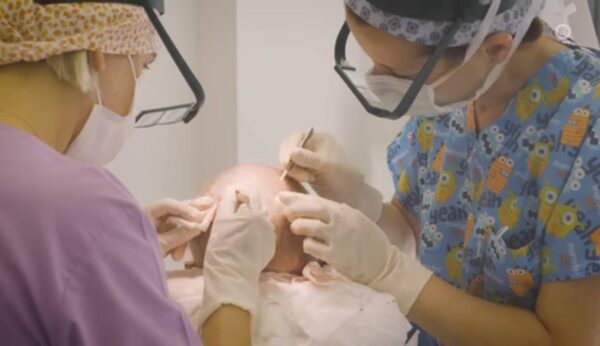What is the Throat Cancer?
Throat cancer is growth of abnormal cells in the throat, voice box or tonsils. It happens when cells in these areas start growing uncontrollably and form tumors.
What are the Early Signs of Throat Cancer?
1. Persistent Hoarseness or Voice Changes
- What it feels like: Your voice might become rough, raspy or strained for no apparent reason. Some people notice a lower pitch or difficulty speaking clearly.
- Why it happens: Cancerous growths in or near the larynx (voice box) can interfere with vocal cord function, cause to changes in your voice.
- When to worry: If hoarseness lasts longer than two weeks without a clear cause like a cold or overuse.
2. Sore Throat That Doesn’t Heal
- What it feels like: A constant sore or scratchy feeling in the throat that doesn’t improve with typical remedies like lozenges or antibiotics.
- Why it happens: Tumors in the throat can irritate the lining, causing ongoing discomfort.
- When to worry: If the soreness persists for weeks or worsens over time.
3. Difficulty Swallowing (Dysphagia)
- What it feels like: A sensation that food is stuck in your throat or experiencing pain or discomfort while swallowing.
- Why it happens: Tumors in the throat or esophagus can narrow the passage, making it harder for food and liquids to pass through.
- When to worry: If swallowing becomes consistently painful or progressively more difficult.
4. Lump or Swelling in the Neck
- What it feels like: A painless lump or swelling on one side of the neck that doesn’t go away.
- Why it happens: Cancer cells can spread to nearby lymph nodes so causing them to enlarge.
- When to worry: If the lump persists for more than two weeks or grows in size.
5. Chronic Cough or Coughing Up Blood
- What it feels like: A dry, persistent cough or small amounts of blood in the sputum when coughing.
- Why it happens: Throat irritation caused by cancer can lead to chronic coughing. In some cases, tumors may cause small blood vessels to rupture.
- When to worry: If the cough lasts more than a few weeks or you notice blood in your sputum.
6. Ear Pain or Pressure
- What it feels like: Persistent pain or a feeling of fullness in one or both ears, often without hearing issues or infection.
- Why it happens: Tumors in the throat can press on nerves connected to the ears, lead to referred pain.
- When to worry: If ear pain doesn’t resolve with standard treatments or occurs without an ear infection.
7. Unexplained Weight Loss
- What it feels like: Losing weight without trying, even if your eating habits remain the same.
- Why it happens: Cancer can increase the body’s energy demands and affect appetite, cause to unintended weight loss.
- When to worry: If you lose 10 pounds or more without any lifestyle changes.
8. Persistent Bad Breath (Halitosis)
- What it feels like: Consistently bad-smelling breath that doesn’t improve with brushing, flossing or mouthwash.
- Why it happens: Cancerous tissues can break down and produce a foul odor, contributing to halitosis.
- When to worry: If bad breath is new, unexplained and persists despite good oral hygiene.
9. Difficulty Breathing
- What it feels like: A sensation of tightness in the throat or difficulty taking deep breaths.
- Why it happens: Tumors can partially obstruct the airway, making it harder to breathe normally.
- When to worry: If breathing becomes noticeably labored or accompanied by wheezing sounds.
10. Fatigue and General Malaise
- What it feels like: Feeling unusually tired or run-down, even after adequate rest.
- Why it happens: Cancer can affect the body’s ability to produce energy and fight off the disease, cause to persistent fatigue.
- When to worry: If fatigue is severe and doesn’t improve with rest or normal remedies.



What are the Causes of Throat Cancer?
1. Tobacco Use
- How it causes cancer: Smoking cigarettes, cigars or pipes introduces carcinogenic chemicals into the throat and lungs. These substances can damage the DNA of throat cells, cause to cancer.
- Forms of tobacco linked to throat cancer:
- Smoking (cigarettes, cigars, pipes)
- Chewing tobacco
- Snuff or smokeless tobacco
2. Excessive Alcohol Consumption
- How it causes cancer: Chronic alcohol use irritates and damages the lining of the throat. It also reduces the body’s ability to repair DNA damage.
- Combined effect: The combination of alcohol and tobacco use significantly increases the risk of throat cancer.
3. Human Papillomavirus (HPV)
- What it is: Sexually transmitted infection linked to various cancers, like throat cancer.
- How it causes cancer: Certain high-risk strains of HPV (like HPV-16) can cause mutations in throat cells, cause to cancer, particularly in the oropharynx (part of the throat behind the mouth).
- Who is at risk: People with multiple sexual partners or those who engage in unprotected oral sex are at higher risk.
4. Chronic Acid Reflux (GERD)
- What it is: Gastroesophageal reflux disease (GERD) involves stomach acid frequently backing up into the throat.
- How it causes cancer: Persistent acid exposure can damage throat tissues, increasing the risk of cancer, particularly esophageal and laryngeal cancers.
5. Poor Nutrition
- How it contributes: A diet low in fruits, vegetables and essential vitamins (like vitamin A and beta-carotene) may reduce the body’s ability to fight off cell damage.
- Alcohol and poor diet: Chronic alcohol users often have nutritional deficiencies, compounding the risk.
6. Environmental and Occupational Exposures
- Harmful substances: Prolonged exposure to harmful chemicals, such as asbestos, wood dust, formaldehyde or industrial fumes, could be increase the risk of throat cancer.
- Who is at risk: People working in construction, manufacturing or industries with high chemical exposure.
7. Age and Gender
- Age: Throat cancer is more common in people over 50, as DNA damage accumulates over time.
- Gender: Men are more likely than women to develop throat cancer, possibly due to higher rates of smoking and alcohol consumption.
8. Family History
- Genetic predisposition: A family history of throat or other head and neck cancers may increase susceptibility.
9. Weakened Immune System
- How it contributes: A compromised immune system (due to conditions like HIV/AIDS or immunosuppressive medications) reduces the body’s ability to fight off cancer-causing infections like HPV.
10. Previous Cancer Diagnosis
- How it relates: People who have had other forms of head and neck cancer are at higher risk of developing throat cancer.
11. Prolonged Exposure to Ultraviolet (UV) Light
- Specific link: Although rare, prolonged UV light exposure can increase the risk of lip and throat cancers, particularly in individuals who spend a lot of time outdoors without protection.
What are the Treatment Options for Throat Cancer?
1. Surgery
- Purpose: To remove cancerous tumors and some cases, nearby tissues or lymph nodes.
- Types of Surgery:
- Tumor Resection: Removal of the cancerous tissue and some surrounding healthy tissue.
- Laryngectomy:
- Partial Laryngectomy: Removes part of the larynx while preserving speech.
- Total Laryngectomy: Removes the entire larynx, requiring a stoma (opening in the neck) for breathing.
- Pharyngectomy: Removal of part of the throat.
- Neck Dissection: Removal of lymph nodes if cancer has spread to the neck.
- Recovery: May involve temporary or permanent changes in swallowing, speaking, or breathing.
2. Radiation Therapy
- Purpose: Uses high-energy beams (like X-rays) to kill or shrink cancer cells.
- Types:
- External Beam Radiation Therapy (EBRT): The most common method, where a machine directs radiation to the tumor site.
- Brachytherapy: Implants radioactive material directly in or near the tumor.
- Usage:
- Early-stage cancer: Often used alone.
- Advanced cancer: Combined with chemotherapy or surgery.
- Side Effects: Sore throat, dry mouth, hoarseness, difficulty swallowing and skin irritation.
3. Chemotherapy
- Purpose: Uses drugs to kill cancer cells or stop them from growing and dividing.
- Usage:
- Combined with radiation (chemoradiation) for advanced-stage cancer.
- To shrink tumors before surgery (neoadjuvant chemotherapy).
- To control symptoms in metastatic cancer.
- Common Drugs: Cisplatin, carboplatin and 5-fluorouracil (5-FU).
- Side Effects: Nausea, vomiting, hair loss, fatigue and increased infection risk.
4. Targeted Therapy
- Purpose: Uses drugs that specifically target cancer cell mechanisms, like proteins or genes.
- Example: Cetuximab (Erbitux), which targets the epidermal growth factor receptor (EGFR) to slow tumor growth.
- Usage: Often used for advanced or recurrent throat cancer, either alone or with chemotherapy and radiation.
- Side Effects: Skin rash, diarrhea and fatigue.
5. Immunotherapy
- Purpose: Boosts the immune system to recognize and attack cancer cells.
- Example: Immune checkpoint inhibitors like pembrolizumab (Keytruda) or nivolumab (Opdivo) are often used for advanced or recurrent throat cancer.
- Usage: Typically for cases that don’t respond to other treatments.
- Side Effects: Flu-like symptoms, fatigue and inflammation in various parts of the body.
6. Speech and Swallowing Therapy
- Purpose: Helps patients regain or adapt speech and swallowing functions after treatment.
- Techniques:
- Using voice prostheses after laryngectomy.
- Exercises to strengthen throat muscles for swallowing.
7. Nutritional Support
- Why it’s needed: Treatments can make swallowing difficult, leading to weight loss and malnutrition.
- Methods:
- Temporary feeding tubes (nasogastric tube or PEG tube).
- Diet adjustments, such as soft or liquid foods.
8. Palliative Care
- Purpose: Focuses on relieving symptoms and improving quality of life, especially for advanced cancer.
- Approaches:
- Pain management with medications.
- Psychological support and counseling.


Is There a Connection Between Oral Sex and Throat Cancer?
There is a connection between oral sex and throat cancer, primarily through the human papillomavirus (HPV). HPV is a sexually transmitted infection and certain high-risk strains, such as HPV-16, are strongly associated with oropharyngeal cancer, which affects parts of the throat, including the base of the tongue, tonsils and the soft palate. Here is explanation:
How Oral Sex Increases the Risk
- HPV Transmission:
- HPV can be transmitted through oral sex with an infected partner. The virus can infect the mucosal surfaces of the throat, cause to changes in the cells and over time, potentially causing cancer.
- HPV-16 is the strain most commonly linked to throat cancers caused by the virus.
- Prevalence:
- HPV-related throat cancer is increasing, particularly in younger individuals and non-smokers, due to changes in sexual practices, including more frequent oral sex.
- Latency Period:
- HPV infections may remain dormant for years before causing noticeable issues, which means that the link between oral sex and throat cancer can take decades to manifest.
Why HPV Causes Cancer
HPV can disrupt normal cell function by integrating its DNA into the host cells. This cause to:
- Uncontrolled cell growth: Resulting in tumors.
- Immune evasion: Making it harder for the body to clear the infection naturally.
Risk Factors
- Multiple Sexual Partners: Having more partners increases the likelihood of exposure to HPV.
- Unprotected Oral Sex: Using protection (e.g., condoms or dental dams) reduces but does not eliminate, the risk.
- Smoking and Alcohol Use: These behaviors weaken the immune system, making it harder to fight off HPV infections and increasing the risk of cancer.
Preventing HPV-Related Throat Cancer
- HPV Vaccination:
- Vaccines like Gardasil can protect against high-risk HPV strains, including HPV-16.
- Vaccination is recommended for both males and females, typically starting in adolescence.
- Safe Sexual Practices:
- Using protection during oral sex reduces the risk of HPV transmission.
- Limiting the number of sexual partners can also lower exposure risk.
- Regular Health Check-Ups:
- Early detection of any abnormal throat symptoms (like persistent sore throat or lumps) can improve outcomes.

